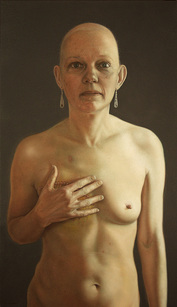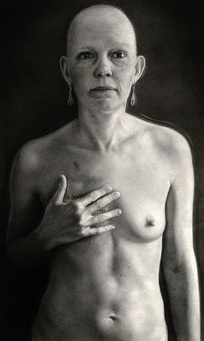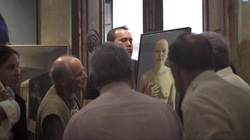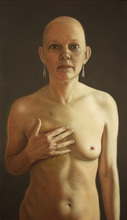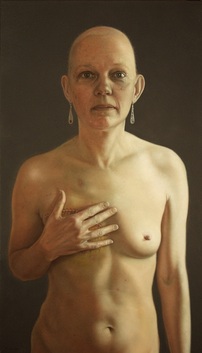 AGAVE MAGAZINE, September 2014 THE STORY OF WONDER WOMAN 09/14/2014 By Deb A. The smallest painting in the Museu Europeu d'Art Modern (MEAM) in Barcelona technically has no business being there--but the sheer power of how it depicts its subject has helped it make the journey from small-town Canada to the home of some of the world’s best modern art. It is called Wonder Woman, and it is by Agave Magazine's Artist-in-Residence Tony Luciani. The story of how it came to be involves equal parts goodwill and fear, and an extraordinary amount of passion. A week after Tony met Monica, doctors discovered a lump in her breast. Over the next four years, their relationship would be marked not just by love and devotion, but also by doctor’s visits, cancer treatments, and an ever-changing outlook for the future. To release the stress and trepidation he and Monica were navigating together, Tony asked Monica to sit for a portrait. Although he admits to hating painting, Tony (who prefers to draw) was so moved by the process of bringing Monica’s likeness to life on canvas that it brought tears to his eyes. In a sense, Wonder Womanwas his diary. “It wasn’t just a portrait,” he explains. “It was deeper than that.” And like most diary entries, it was a secret: only two people in the world knew that the portrait even existed, and Monica made Tony promise he would never show it to anyone. So when Tony’s dealer mentioned a portrait competition and asked whether he had anything to submit, he did not. Until one day, despite not having even seen her own portrait, Monica changed her mind. She had realised, she told Tony, that, “The painting isn’t about me. It’s about people like me. If it can help others… go ahead.” Monica’s observation wasn’t the whole story: it was true that the portrait represented more than just her, but it also stood for more than others like her as well. Had she seen the painting, she would have immediately understood that its undeniable power went beyond the mastectomy, the bald head, the scar she protected--not hid--with a single hand. It went beyond the earrings that served as a gentle reminder that this was not a painting of a victim, but of a woman who would always be beautiful. The focus of the portrait’s power was in the eyes, which were somehow Tony’s, too: their emotions combined, his gaze joining hers to confront the viewer with just as much strength as vulnerability. Wonder Woman was submitted, accepted, and sent on a tour across Canada. Monica first saw the portrait at the opening of the Kingston Prize, where it became the centre of controversy due to the subject's nudity. Wonder Woman won no prize that night. Nor was Tony able to find a gallery that would accept Wonder Woman, even as a donation. It was a difficult painting that demanded commitment, completely unsuited to a quick glance, and the artist himself was unfashionable on two counts: he was unknown and still living. Wonder Woman stayed in a crate. After Monica died, Tony couldn’t bear the thought of losing both the real person and her canvas likeness, a testimony to their shared strength and love. He began to look again for a proper home for Wonder Woman, winning several online awards in the process... but most organisations only wanted the image, not the actual painting. It wasn’t until the MEAM shortlisted Wonder Woman for an exhibition and a potential $50,000 grand prize that the portrait would be seen again. Technically, the painting was too small to be eligible at all for the competition, but the organisers were so moved by the work that an exception was made: the portrait could not win the grand prize, but it would be part of the exhibit. Tony was elated. He was even happier when he realised that he’d found Wonder Woman a permanent home. When a MEAM official confided to Tony that although the painting was the smallest in the museum, it was, in his opinion, the one with the most meaning, Tony offered it to the museum on the spot. He refused payment; he couldn’t accept money for something that was so private and personal, especially considering that originally, he had never intended for anyone to see it at all. And so, now a part of the MEAM's permanent collection, Wonder Woman now hangs: defiant, challenging, and impossible to ignore. For a more in-depth understanding of Wonder Woman's journey, we recommend Willa Wick's article, 'Wonder Woman', in the February 2014 issue of The Rural Route. AGAVE MAGAZINE, Vol. 2, Issue 1, Summer 2014, (Deb.A.)
5 Questions with Tony Luciani Agave Magazine is proud to announce our very first Artist-in-Residence, Tony Luciani. Tony’s artwork has been a captivating staple of Agave so far: we introduced the magazine to the world with his painting, “Chiesa di San Francesco”, on the cover, and “Wonder Woman” stopped readers in their tracks in Issue 2. Influenced by the Renaissance Masters as well as Antonio López Garcia, Käthe Kollwitz, and Lucian Freud, his immense technical talent is rivaled only by his instinctive ability to elicit powerful emotional responses. In this first interview, Tony discusses drawing as an underrated art form, art as compulsion, and his ultimate goals. AGAVE MAGAZINE: Do you prefer to paint or draw? TONY LUCIANI: Drawing, without a question. For me, it’s much more immediate and rewarding, whereas my paintings can take months, with no guarantee of success. I love the variable grey tonalities of the charcoals. Drawing has had a history of being identified as inferior to painting, with works on paper usually labelled as sketches or preparatory studies. I’d like to think that worked-out compositions, details, tonal values, depth and the overall thought process can give more for the viewer to absorb than just a finished canvas. I want to see the whole story, not just the credits at the end. And besides, I’d like to think my drawings stand up for themselves, even without a final painting. What has been your most challenging piece? I was going to say my most challenging piece was my most compositionally complicated, but, I will go the other way with it and say ‘Wonder Woman’ was the one. It was a work that was very personal and meant to subdue the heart-wrenching stress I was going through with my partner’s breast cancer. The work was never meant to be shown. It was of a beautiful person who was being stripped of her dignity: right breast removed, hair fallen out, yet the simplicity of life and survival was hopefully captured in her eyes and body language. The earrings symbolized that she still was a woman no matter what was taken away. You have created a strict work schedule for yourself that demands dedication. What motivates you to do what you do? I don’t think of it as “motivation” as such. I feel it is more of a need. Of course I love what I do, and creating something from nothing gives me a tremendous feeling of accomplishment. That last sentence reminds me of what a minister friend told me years ago as we played our weekly game of chess together. After a couple of chess moves in the quiet of a summer’s night, he said, “Tony, I look at your art, and now I feel I can almost relate to what God must have felt when He created something from nothing.” A bit of an exaggerated analogy on his part, but nonetheless, for me, a compliment. And yet sometimes, the motivation comes with the fear of not knowing what else I want to do, or can do. What would you like viewers to gain from your art? I can’t expect that every work I do will give the viewer a feeling. That’s not realistic. Though my objective is to transfer the understanding from thought to the sensation of ‘hum.’ That’s the feeling in the gut verses the nit-picking of the brain. Those head-scratching summations are best left to the art critics. What do you personally hope to achieve through your work? For me? Meaning. For others? Meaning. 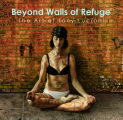 My painting, Wonder Woman, was selected for the exhibition FIGURATIVAS '13, 7th Concurso de Pintura Y Escultura, at MEAM; Museu Europeu d'Art Modern, in Barcelona, Spain. Jury panel included distinguished international artists: Spanish painter Antonio Lopez Garcia, Austrian painter Gottfried Helnwein, Swedish artist Odd Nerdrum, American Jacob Collins, and with Tomas Walls, James S. Echeberría and Eduardo Naranjo. http://www.meam.es/ _________________________________________________________________________________________________________________________ My painting, Madonna and Mannequin, was selected for 2013 THE KINGSTON PRIZE; Canada's National Juried Portrait Competition. http://www.kingstonprize.ca _________________________________________________________________________________________________________________________ My painting, Chiesa di S. Francesco, is on the cover for the inaugural edition of AGAVE MAGAZINE. http://www.agavemag.com/index.html _________________________________________________________________________________________________________________________ Beyond Walls of Refuge A beautiful hard cover, 12" x 12", 100 page full colour coffee table art book with sixty paintings and drawings, including descriptive text from the 2012 Wellington County Museum and Archives exhibition. Orders now accepted. Email artist@tonyluciani.ca for requests and/or further details, or go to http://www.blurb.ca/bookstore and insert Tony Luciani or Beyond Walls of Refuge in the search box for a complete preview & purchase. *Now available in a smaller 7" x 7" hard or soft cover format as well. See above link for details. |
|
